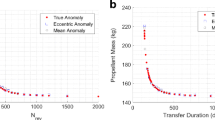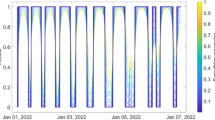Abstract
Because the orbital periods for planetary orbital transfers are of order hour, the primary objective of an optimal trajectory is to minimize the propellant consumption. In this paper, we present a systematic investigation of optimal trajectories for planetary orbital transfer. Major results on thrust control, propellant consumption, and flight time are presented with particular reference to LEO-to-GEO transfer. The following results were obtained with the sequential gradient-restoration algorithm in either single-subarc form or multiple-subarc form:
-
(i)
For minimum propellant consumption, the thrust direction is tangent to the flight path. The thrust magnitude has a three-subarc form: powered flight with maximum thrust is followed by coasting flight, which is followed by powered flight with maximum thrust.
-
(ii)
The flight time is determined mainly by the thrust-to-weight ratio. A transfer via chemical engines is relatively short: usually, it requires less than one cycle to achieve the mission, which involves a large portion of coasting flight. A transfer via electrical engines is relatively long: usually, it requires a multicycle spiral trajectory to achieve the mission, which involves a large portion of powered flight, mostly in the first subarc.
-
(iii)
The propellant consumption is determined mainly by the specific impulse: the electrical engine is more efficient than the chemical engine, resulting in lower propellant consumption and higher payload.
Similar content being viewed by others
References
A.L. Herman D.B. Spencer (2002) ArticleTitleOptimal Low-Thrust Earth-Orbit Transfers Using Higher-Order Collocation Methods Journal of Guidance, Control, and Dynamics 25 IssueID1 40–47
L.M. Mailhe S.D. Heister (2002) ArticleTitleDesign of a Hybrid Chemical/Electric Propulsion Orbital Transfer Vehicle Journal of Spacecraft and Rockets 39 IssueID1 131–139
C.D. Hall V. Collazo-Perez (2003) ArticleTitleMinimum-Time Orbital Phasing Maneuvers Journal of Guidance, Control, and Dynamics 26 IssueID6 934–941
A. Miele T. Wang (1999) ArticleTitleOptimal Trajectories and Mirror Properties for Round-Trip Mars Missions Acta Astronautica 45 IssueID11 655–668 Occurrence Handle10.1016/S0094-5765(99)00117-4
A. Miele T. Wang S. Mancuso (2000) ArticleTitleOptimal Free-Return Trajectories for Moon Missions and Mars Missions Journal for the Astronautical Sciences 48 IssueID2–3 183–206
A. Miele T. Wang S. Mancuso (2001) ArticleTitleAssesment of Launch Vehicle Advances to Enable Human Mars Excursions Acta Astronautica 49 IssueID11 563–580 Occurrence Handle10.1016/S0094-5765(01)00008-X
A. Gipsman M. Guelman A. Kogan (1999) ArticleTitleAutonomous Navigation and Guidance System for Low-Thrust Driven Deep Space Missions Acta Astronautica 44 IssueID7 353–364 Occurrence Handle10.1016/S0094-5765(99)00058-2
M.D. Rayman P.A. Chadbourne J.S. Culwell S.N. Williams (1999) ArticleTitleMission Design for Deep Space 1: A Low-Thrust Technology Validation Mission Acta Astronautica 45 IssueID4 381–388 Occurrence Handle10.1016/S0094-5765(99)00157-5
G.B. Ganapathi C.S. Engelbrecht (2000) ArticleTitlePerformance of the Xenon Feed System on Deep Space One Journal of Spacecraft and Rockets 37 IssueID3 392–398
A. Axelrod M. Guelman D. Mishne (2002) ArticleTitleOptimal Control of Interplanetary Trajectories Using Electrical Propulsion with Discrete Thrust Levels Journal of Guidance, Control, and Dynamics 25 IssueID5 932–939 Occurrence Handle10.2514/2.4966
S.N. Williams V. Coverstone-Carroll (2000) ArticleTitleMars Missions Using Solar-Electric Propulsion Journal of Spacecraft and Rockets 37 IssueID1 71–77 Occurrence Handle10.2514/2.3528
S.R. Vadali R. Nah E. Braden I.L. Johnson (2000) ArticleTitleFuel-Optimal Planar Earth-Mars Trajectories using Low-Thrust Exhaust-Modulated Propulsion Journal of Guidance, Control and Dynamics 23 IssueID3 476–482 Occurrence Handle10.2514/2.4553
R. Bertrand J. Bernussou S. Geffroy R. Epenoy (2001) ArticleTitleElectric Transfer Optimization for Mars Sample Return Mission Acta Astronautica 48 IssueID5–12 651–660
A. Miele T. Wang V.K. Basapur (1986) ArticleTitlePrimal and Dual Formulations of Sequential Gradient-Restoration Algorithms for Trajectory Optimization problems Acta Astronautica 13 IssueID8 491–505 Occurrence Handle10.1016/0094-5765(86)90028-7 Occurrence Handle0619.70028
B.H. Rishikof B.R. McCormick R.E. Pritchard S.J. Sponaugle (1992) ArticleTitleSEGRAM: A Practical and Versatile Tool for Spacecraft Trajectory Optimization Acta Astronautica 26 IssueID8–10 599–609
A. Miele T. Wang (2003) ArticleTitleMultiple-Subarc Sequential Gradient-Restoration Algorithm, Part 1: Algorithm Structure Journal of Optimization Theory and Applications 116 IssueID1 1–17 Occurrence Handle1961025 Occurrence Handle1029.49030
A. Miele T. Wang (2003) ArticleTitleMultiple-Subarc Sequential Gradient-Restoration Algorithm, Part 2: Application to a Multistage Launch Vehicle Design Journal of Optimization Theory and Applications 116 IssueID1 19–39 Occurrence Handle1961026 Occurrence Handle1029.49031
Miele A., Wang T., and Williams P. N., Computation of Optimal Trajectories via Combined Chemical/Electrical Propulsion, Part 1: Baseline Solutions for Deep Interplanetary Space. Paper IAC-02-A.6.05, 53rd International Astronautical Congress, Houston, Texas, 2002; see also Acta Astronautica 55(2): 95–107, 2004
Miele A., Wang T., and Williams P. N., Computation of Optimal Trajectories via Combined Chemical/Electrical Propulsion, Part 2: Minimum Time Solutions with Bounded Thrust Direction. Paper AAS-03-121, 13th Annual AAS/AIAA Space Flight Mechanics Meeting, Ponce, Puerto Rico, 2003 (to appear in Acta Astronautica)
Miele A., Wang T., and Williams P. N.,Computation of Optimal Trajectories via Combined Chemical/Electrical Propulsion, Part 3: Compromise Solutions. Paper AAS-03-577, AAS/AIAA Astrodynamics Specialist Conference, Big Sky, Montana, 2003 (to appear in Acta Astronautica)
Miele A., and Wang T., Fundamental Properties of Optimal Orbital Transfers. Paper IAC-03-A.7.02, 54th International Astronautical Congress, Bremen, Germany, 2003.
A. Miele (1962) Flight Mechanics 1: Theory of Flight Paths Addison-Wesley Publishing Company Reading, Massachusetts
A. Miele R.R. Iyer (1971) ArticleTitleModified Quasilinearization Method for Solving Nonlinear, Two-Point Boundary-Value Problems Journal of Mathematical Analysis and Applications 36 IssueID3 674–692 Occurrence Handle10.1016/0022-247X(71)90048-5 Occurrence Handle288966 Occurrence Handle0226.65058
A. Miele M. Ciarcia J. Mathwig (2004) ArticleTitleReflections on the Hohmann Transfer Journal of Optimization Theory and Applications 123 IssueID2 233–253 Occurrence Handle10.1007/s10957-004-5147-z Occurrence Handle2101404
Author information
Authors and Affiliations
Additional information
portions of this paper were presented by the senior author at the 14th annual aas/ aiaa space flight mechanics meeting, maui, hawaii, 8–12 february 2004 (paper aas-04-232).
This research was supported by NSF Grant CMS-02-18878.
Rights and permissions
About this article
Cite this article
Miele, A., Wang, T. Optimal Planetary Orbital Transfers via Chemical Engines and Electrical Engines. J Optim Theory Appl 127, 587–604 (2005). https://doi.org/10.1007/s10957-005-7505-x
Issue Date:
DOI: https://doi.org/10.1007/s10957-005-7505-x




